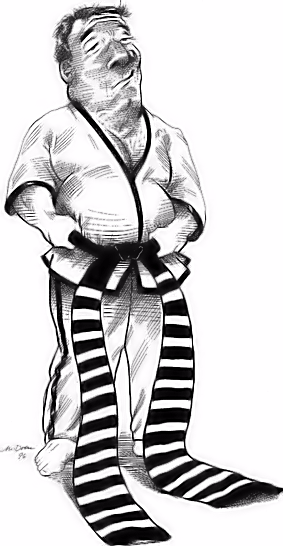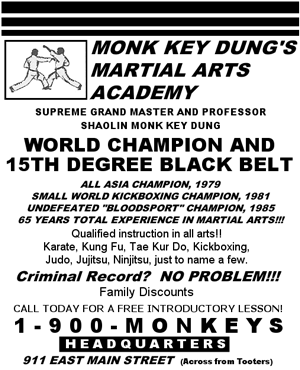
In 1260 A.D., the Yuan government made paper money the only legal tender throughout the Chinese empire. No longer would a nation's wealth and prestige be seen by enormous stacks of gold and silver, but by the faces and images on its paper currency. Paper money offers numerous benefits over minted coinage (it's lighter to carry around for one thing), and as long as an economy remains productive paper currency works very well — so well, in fact, that today it is used around the world. No rational nation on the earth would ever consider going back to a gold standard. However, for all of its benefits, paper money has two major weaknesses: It is highly susceptible to forgery and inflation. So it is with the martial arts. Although all Asian martial arts did not originate in China, it is still fair to say that the all Asian martial arts have, to varying degrees, been influenced by China's martial traditions. Like China's paper money, Asian martial arts have spread throughout the world. However, just as currency evolved from gold and silver to paper representations of the same, so too have the martial arts. No longer are the martial arts represented by the skill and power of its practitioners, but by the faces, images, and signatures displayed on "black belt" certificates. Moreover, with all of its popularity, martial arts, like paper currency, have proven highly susceptible to, you guessed it, forgery and inflation. This is most obvious when we consider the denomination of choice, the black belt. The question sounds simple enough, yet despite the plethora of martial art publications today, there are surprisingly few books or articles that attempt to define or even describe exactly what a black belt is. In fact, my own search of more than a dozen martial art texts and numerous periodicals turned up not a single definition of the highly "coveted" rank. To find one I had to turn to stable references such as encyclopedias and dictionaries. The 1998 edition of Encyclopedia Britannica refers to a black belt in the context of judo. "White belts are worn by novices and black by masters, with intermediate grades denoted by other colors." (So, masters wear black belts. Hmmm.) According to Webster's New World Dictionary (1984) a black belt is "awarded to an expert of the highest skill in judo or karate" [emphasis added]. If these definitions are indicative of the uninitiated public's perception of a black belt, then a black belt in their
eyes is at least "an expert of the highest skill" (except, of course, to those who have successfully beaten up
one or more claimants). Some may disagree that this is the public's perception, but how many times have martial
artists — black belts — heard comments like, "I'll be sure not to mess with you" or "We're all safe with you
around," after being introduced and identified as a black belt? Arguments to the contrary aside, the general
association of the term "black belt" with attainment of the highest level of expertise in the martial arts is a common
one. Defacto Standard Ask a dozen instructors, "What is a black belt?" and you will receive a 12 very different answers. Granted, most of the differences can be attributed to stylistic issues (e.g. Chinese practitioners say there is so much more to learn in their arts that it simply takes longer to earn a black belt in their schools than it does in those that teach other Asian arts), but other differences are essentially market-driven. For instance, one school owner confided, "My students' parents expect their child will be a second-degree black belt by age 12. If not, they will take him elsewhere." Ironically, the general public has a fairly uniform understanding what is a black belt — an expert of the highest skill — yet many parents expect their children will attain that level before they reach puberty. Inflated parental estimations and expectations aside, does anyone really believe that the local Mini Hanshi Karate-Mart can produce genuine "experts of the highest skill" before the candidates reach puberty, much less maturity? It is just such situations that make the question, "What is a black belt?" highly relevant because we (martial art practitioners and instructors) are evaluated and compared based on the public's perceptions and expectations — as whimsical and unrealistic as they may be.
Given the great disparity between public perception and reality, martial artists to whom the belt is still "coveted" are
increasingly pressured to lower their standards. Those who refuse face extinction. Refusing to compromise
their standards, many, even now, teach only in small I-wish-it-could-be-for-profit schools, holding day jobs to make
their living.
Everything and Nothing The real problem remains — and this is the core issue — that the black belt represents an ideal, not some tangible product; and just as paper currency is only as strong as the government that stands behind it, a black belt certificate is only as good as the training that went into it, the standards that were met to earn it, and the instructor who awarded it. Black belt, then, means, simultaneously, everything and nothing. Everything for the life-long practitioner. Everything for the individual whose life depends on "expert" skill. Nothing to those who routinely turn out inflated paper certificates.
Having made my points about "What is a Black Belt?", the following words by John Graden, provide a great closing statement. The only two ranks that matter are white belt and black belt. White belt represents courage [the courage to risk failure] and black belt represents persistence and follow through. ... The world is full of great starters, but it is the ability to follow through to the end, that separates the best of us from the rest of us.3 |
|||||||||
|
Footnotes:
Je du-too School of Martial Arts Black Belt Recipients:
|
|
©Copyright Bob Orlando, 2000-2016 All rights reserved. |
http://www.OrlandoKuntao.com
E-mail: Ron@OrlandoKuntao.com |
Last update:
Aug. 6, 2016 by Bob Orlando |

